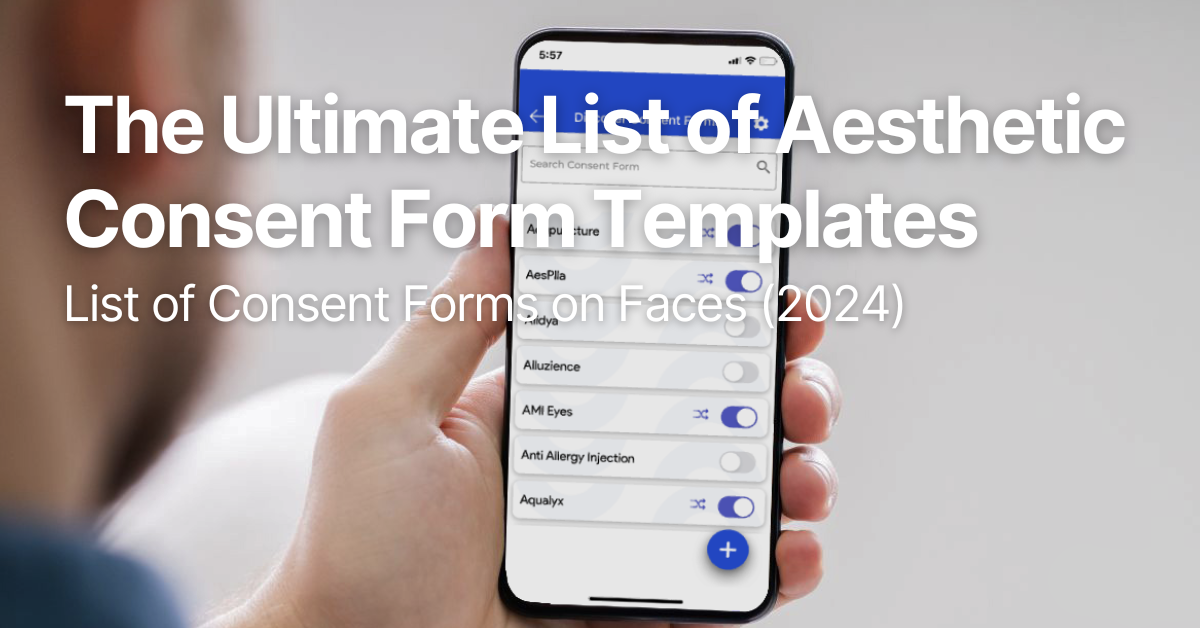
Consent forms. The main reason why practitioners have been using Faces for a long time now and the reason why Faces is getting popularity. Though Faces has since transformed into more than a tool to store, create, and use consent forms, 97% of our users are continuously using Faces for forms, along with other features such as our website builder, prescription services, finance, accounting services, and more!
If you’re still new to Faces, and want a complete overview of our forms, bookmark this page! We’ll continuously update this page to inform you of the latest consent forms that have been added to Faces.
Full List of Faces’ Consent Forms:
Acupuncture
AesPlla
Alidya
Alluzience
AMI Eyes
Anti Allergy Injection
Aqualyx
AquaShine BTX
Azzalure
Baby Botox
BB Glow
BeautiFeye NCTF
Bio Filler
BioRePeel
Biotin Injection
Birthmark Removal
Blood Test
Blue Peel
Bocouture
Body Contouring
Body Dysmorphic Disorder Questionnaire (BDDQ)
Body HIFU
Body Piercing
Botox
Botox for Hyperhidrosis
Botulinum Toxin
Brazilian Lymphatic Drainage Massage
Breast Vacuum
Brow Lamination
Bum Filler
Bum Lift and Breast Enhance
Bum Vacuum Therapy
CACI Facial
Carbon Laser Peel
Carboxytherapy
Celluma
Chemical Peel
Cincelar
Cold Plasma Therapy
Colon Hydrotherapy
Cosmelan
COVID-19 Pandemic
Cryolipolysis
Cryotherapy
Deep Oscillation Therapy
Dental Block
Dermaeyes 2.0
Dermal Filler
Dermapen
Dermaplaning
Dermaroller
Deso Face and Body Fat Dissolving via Mesotherapy
Dr CYJ Hair Filler
Ear Microsuction
Electrolysis Hair Removal
Electrolysis Vein Removal
ELOS Skin Rejuvenation
EMsculpt
Epilfree
EpiPen
Eyebrow Lift with Filler
Eyebrow Threading
Eyebrow Waxing
Eyelash Extension
Eyelash Serum (Bimatoprost)
Face Bleaching
Face HIFU
Facial
Fat Dissolving
Fibroblast
Flu Vaccine
Foot Health
Fractional CO2 Laser
Fraxel
Full Body Exfoliation
Glutathione Injections
Gouri
Hair Colour
Hair Extensions
Hair Filler
Hair Mesotherapy
Hand Rejuvenation with Radiesse
HarmonyCa
Hay Fever Injection
HD Brows
High Frequency Facial
Hijama Cuppings Therapy
Hopi Ear Candling
Hyaluron Pen Filler
Hyaluronidase
Hydrafacial
Hydrodermabrasion
Hydrofacial
Hydropen
Illuma Luna Skin Booster
Illuma PN Skin Booster
Indian Head Massage
Intense Pulse Light (IPL)
Iron Intramuscular Injection
IV Infusion Therapy
Jalupro Classic & HMW
Juvederm
Kabelline Contouring Serum
Laser Hair Removal
Laser Lipo
Laser Tattoo Removal
Laser Tattoo Removal Waiver Form
Laser Vein Removal
Lash and Brow Tint
Lash and Henna Brow
Lash Lift
LED Facial Therapy
Lemon Bottle Fat Dissolving
Lidocaine
Lip Tattoo
Lipo Lab
Lipolax
Liposuction Seroma Aspiration
Lumi Eyes
Lumifil
Makeup
Manual Lymphatic Drainage
Massage Therapy
Medical Form
MesoPeel
Mesotherapy
Microblading
Microblading Patch Test
Microchanneling
Microdermabrasion
Microneedling
Micropigmentation
Mole Removal
MORPHEUS8
Nail Gel/Acrylic
National Medical Weight Loss Program
Neck HIFU
Nerve Block
No-Needle Mesotherapy
Non Surgical Rhinoplasty
Nucleofill
Omnilux Light Therapy
Ozempic Pen
Pabrinex
Patch Test
PCA Facial
PDO and PLLA Thread Lift
Pedicure Manicure
Permanent Tattoo
Phlebotomy
Photographs Usage Agreement
Plasmapen
Plenhyage XL
PMU
Polynucleotide Injection
Prednisone
Prescription Hair Loss Treatment for Females
Prescription Hair Loss Treatment for Males
Prescription Weight Loss
Profhilo
PRP
PRP Scalp Treatment
PRX T33
Radio Frequency
Reflexology
Reiki Healing Treatment
Revolax
RF Microneedling
Rhinoplasty
Saline Tattoo Removal
Saxenda Treatment
Scalp Micropigmentation
Sclerotherapy
Sculptra
Semi-Permanent Cosmetics
Semi-permanent Eyelashes
Seventy Hyal 2000
Shockwave Therapy
Silhouette Sutures™ Lift
Skin Booster
Skin Tags and Wart Removal
Spray Tanning
SQT Biomicroneedling
Sunekos
Tear Trough
Teeth Whitening
Thai Massage
Thermage
Thread Vein Treatment
TKN HA 3 Bio-Revitaliser
Tooth Gems
Trulicity
Tummy Tuck
Ulthera
Ultrasonic Fat Cavitation
Ultrasound Facial
UV Eyelash Extension
Vaginal HIFU
Vibradermabrasion
Vitamin B Complex
Vitamin B12 Complex IV Infusion
Vitamin B12 Shot
Vitamin B6 Injection
Vitamin C Injection
Vitamin C IV Infusion
Vitamin D Injection
Vitamin D2 Injection
Vitamin D3 Injection
Waxing
Wegovy
Wood Therapy
We’re continuously adding more consent forms every month! If you need help activating the consent forms you need for your business, please send us a WhatsApp message or email us at [email protected].
What’s the next consent form you’d like to see on Faces? Comment down below!




